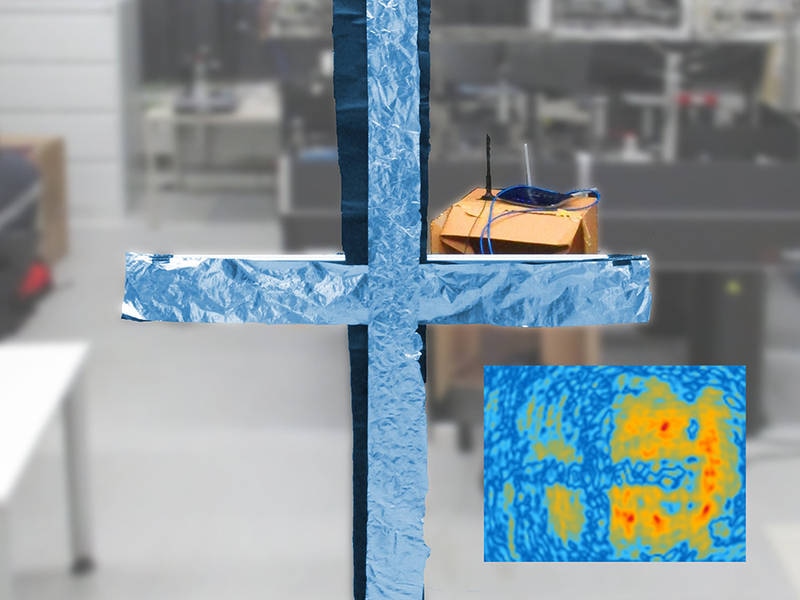May 5 2017
 A cross made of aluminum foil between the viewer and the WLAN-router can easily be reconstructed from the WLAN-hologram as can be seen in the inserted picture (image: Friedemann Reinhard/Philipp Holl / TUM)
A cross made of aluminum foil between the viewer and the WLAN-router can easily be reconstructed from the WLAN-hologram as can be seen in the inserted picture (image: Friedemann Reinhard/Philipp Holl / TUM)
Researchers at the Technical University of Munich (TUM) have created a holographic imaging process that portrays the radiation of a Wi-Fi transmitter to produce 3D images of the surrounding environment. This can be used by industrial facility operators to track objects as they are conveyed through the production line.
Similar to peering through a window, holograms project a seemingly 3D image. While optical holograms require intricate laser technology, producing holograms with the microwave radiation of a Wi-Fi transmitter requires just a single fixed and a single movable antenna, as Dr. Friedenmann Reinhard and Philipp Holl report in the present issue of the distinguished scientific journal Physical Review Letters.
“Using this technology, we can generate a three-dimensional image of the space around the Wi-Fi transmitter, as if our eyes could see microwave radiation,” says Friedemann Reinhard, director of the Emmy Noether Research Group for Quantum Sensors at the Walter Schottky Institute of the TU Munich. The researchers foresee fields of utilization particularly in the domain of industry 4.0 – automated industrial facilities, in which localizing parts and devices is mostly difficult.
Wi-Fi Penetrates Walls
Processes that permit the localization of microwave radiation, even through walls, or in which alterations in a signal pattern indicate the presence of a person already exist. The innovation is that an entire space can be imaged via holographic processing of cell phone or Wi-Fi signals.
Of course, this raises privacy questions. After all, to a certain degree even encrypted signals transmit an image of their surroundings to the outside world. However, it is rather unlikely that this process will be used for the view into foreign bedrooms in the near future. For that, you would need to go around the building with a large antenna, which would hardly go unnoticed. There are simpler ways available.
Friedemann Reinhard, Director, Emmy Noether Research Group for Quantum Sensors
Centimeter-Scale Precision
Until now, making images from microwave radiation required special-purpose transmitters possessing large bandwidths. Using holographic data processing, the minuscule bandwidths of regular household Wi-Fi transmitters operating in the 2.4 and 5 GHz bands were enough for the researchers. Even cell phone and Bluetooth signals can be used. The wavelengths of these devices match a spatial resolution of a few centimeters.
Instead of a using a movable antenna, which measures the image point by point, one can use a larger number of antennas to obtain a video-like image frequency. Future Wi-Fi frequencies, like the proposed 60 gigahertz IEEE 802.11 standard will allow resolutions down to the millimeter range.
Dr. Philipp Holl, technical University of Munich
Looking to the Future
Recognized optical techniques for image processing can also be applied in Wi-Fi holography: One instance is the dark-field methodology used in microscopy, which enhances the recognition of feebly diffracting structures. An advance process is white-light holography in which the researchers use the Wi-Fi transmitter’s remaining small bandwidth to eliminate noise from scattered radiation.
The concept of handling microwave holograms like optical images allows the microwave image to be integrated with camera images. The extra information extracted from the microwave images can be embedded into the camera image of a smartphone, for instance to trace a radio tag linked to a lost item.
But the researchers are only at the start of the technological development. For instance, research on the transparency of specific materials is absent. This knowledge would enable the development of wall paper or paint translucent to microwaves for privacy protection, while transparent materials could be applied in factory production lines to allow parts to be tracked.
The researchers expect that additional advancement of the technology may help in the recovery of victims buried under a collapsed building or an avalanche. While conventional techniques only allow point localization of victims, holographic signal processing could offer a spatial representation of destroyed structures, allowing first responders to move around heavy objects and use cavities in the rubble to methodically elucidate the easiest approach to swiftly reach victims.
The Emmy Noether Program of the German Research Foundation (DFB) and the TUM Junior Fellow Fund provided funding for the research.